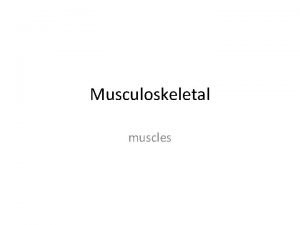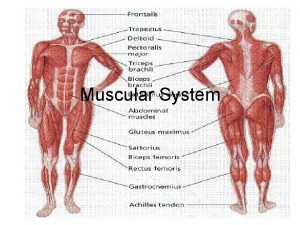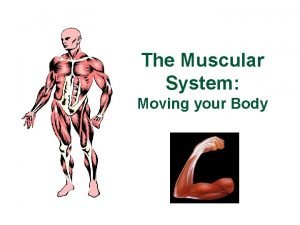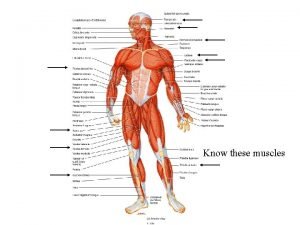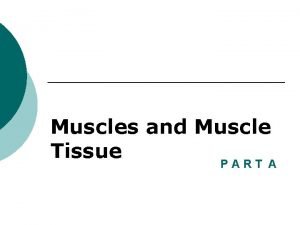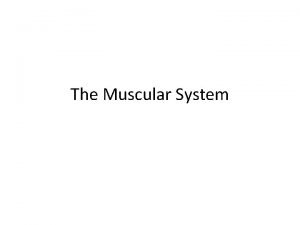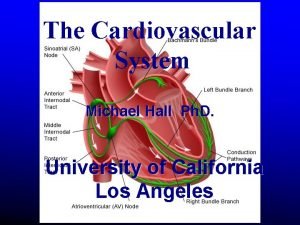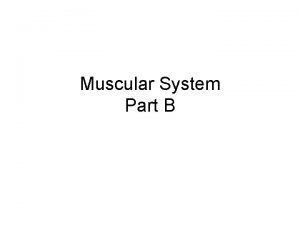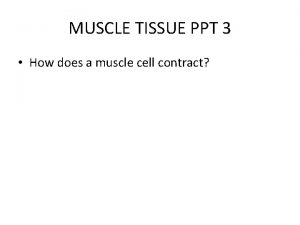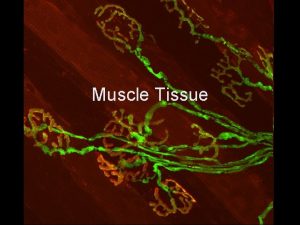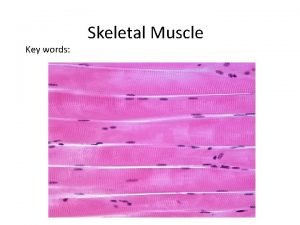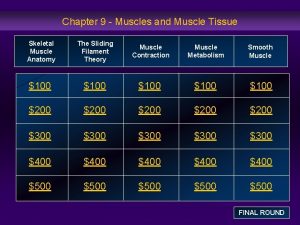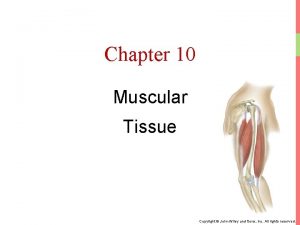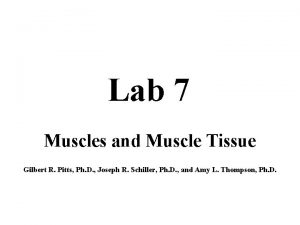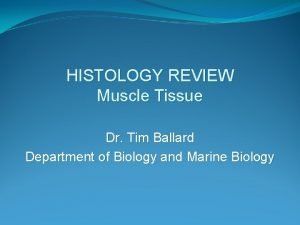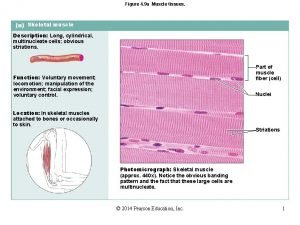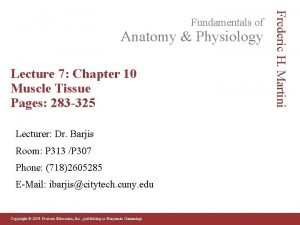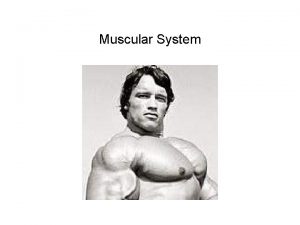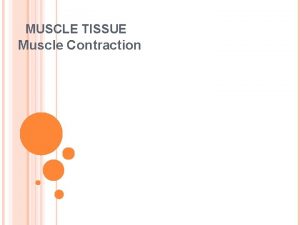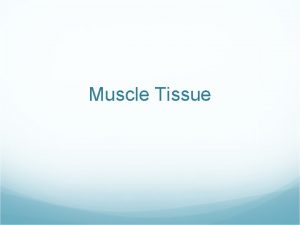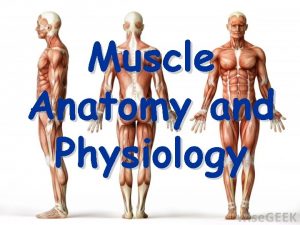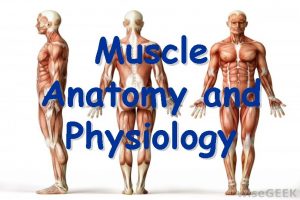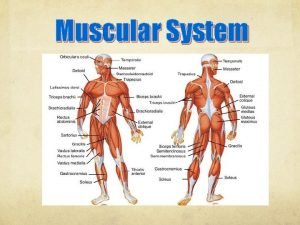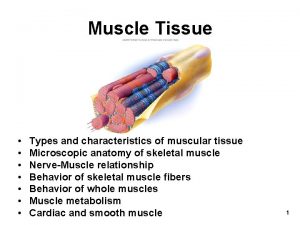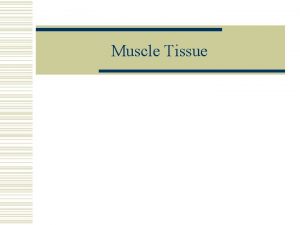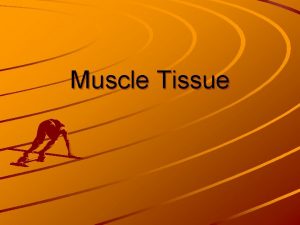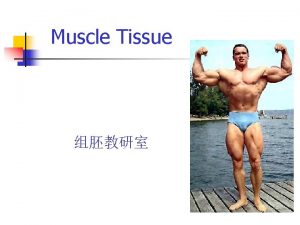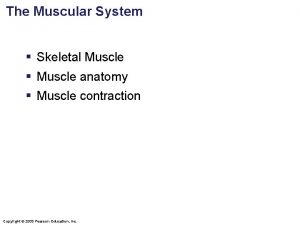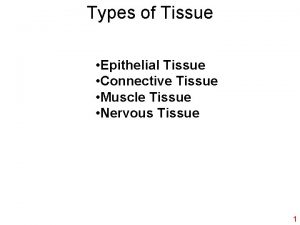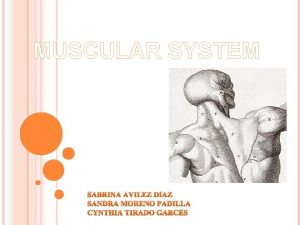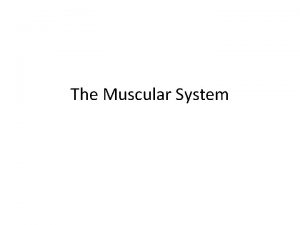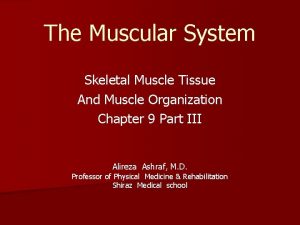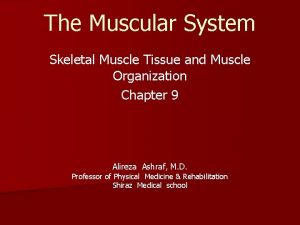The Muscular System 3 Types of Muscle Tissue





















- Slides: 21

The Muscular System

3 Types of Muscle Tissue • Smooth Muscle Tissue – the muscular layers in internal organs (involuntary) • Cardiac Muscle Tissue – the heart muscle • Skeletal Muscle Tissue – responsible for bone movement

How do we move? ? • Ligaments – attach bone to bone

How do we move? ? • Tendons – attach bone to muscle

Types of Skeletal Muscles • Flexor – a muscle that bends a joint when it contracts • Extensor – a muscle that extends a joint when it contracts • Abductor – a muscle that pulls a body part away from the midline of the body • Adductor - a muscle that pulls a body part toward the midline of the body

Antagonistic Muscle Pair

ABDUCTORS

ADDUCTORS

Muscle Functions • Produce movement • Maintain posture • Stabilize joints • Generate heat

Functional Characteristics of Muscle Tissue • Excitability – ability to receive and respond to stimuli • Contractility – ability to shorten forcibly • Extensibility – ability to be stretched or extended • Elasticity – ability to recoil to resting length after a stretch

A skeletal muscle is an organ made up of…. • • Skeletal muscle fibers Blood vessels Nerve fibers Connective tissue

Organization of a Skeletal Muscle The organ is made up of: Fasicles – discrete bundles of muscle cells surrounded by connective tissue Muscle fiber (cell) – elongated multinucleate cell (striated) surrounded by connective tissue Myofibril – rodlike contractile organelle (100’s – 1000’s per cell)


Microscopic Anatomy of a Muscle Fiber (Cell) • Multinucleated - a muscle fiber is a syncytium (a fusion of 100’s of embryonic cells) making one fiber that may be up to 30 cm long • Sarcoplasm - the cytoplasm that contains glycosomes (store glycogen) and myoglobin (stores oxygen)

Microscopic Anatomy of a Muscle Fiber (Cell) • Sarcomere – the smallest contractile units of skeletal muscles

Composition of Sarcomere • Thick filaments – made of the protein myosin • Thin filaments – made of protein actin


Physiology of Muscle Contraction 1. Motor neuron carries an electrical impulse to synapse at neuromuscular junction 2. Calcium helps to release Acetylcholine (neurotransmitter) from neuron which stimulates muscle cell 3. Calcium in muscle cell helps actin/myosin binding (muscle contraction)

Muscle Terms • Myalgia – muscle pain • Myopathy – any disease of muscle • Spasm – involuntary muscle twitch • Cramp – prolonged muscle spasm • Strain – pulled muscle

Homeostatic Imbalance • Many toxins, drugs, and diseases interfere with neuromuscular junction events (ie. myasthenia gravis) • Rigor mortis – ATP needed to relax muscles is not present • Disuse atrophy – immobilized muscles can decrease in strength by 5% per day

Homeostatic Imbalance • Intermittent Claudication – muscle pain due to atherosclerosis • Sarcopenia – muscle loss due to age (muscle strength loss 50% by age 80) • Hernia – organ protrusion through body cavity wall
 Axial muscles
Axial muscles Types of muscle
Types of muscle Skeletal muscle location
Skeletal muscle location Difference between strength and endurance
Difference between strength and endurance Function of muscular tissue
Function of muscular tissue Muscular tissue function
Muscular tissue function Connective tissue
Connective tissue How is aerolar tissue different than aerenchyma tissue?
How is aerolar tissue different than aerenchyma tissue? Muscle tissue function
Muscle tissue function Muscle tissue
Muscle tissue Muscle tissue
Muscle tissue Eccentric movement
Eccentric movement Tropomyosin muscle contraction
Tropomyosin muscle contraction Classification of muscle tissue
Classification of muscle tissue Skeletal muscle tissue description
Skeletal muscle tissue description Muscles and muscle tissue chapter 9
Muscles and muscle tissue chapter 9 John wiley
John wiley Supportive connective tissue
Supportive connective tissue Muscle
Muscle Cross section of skeletal muscle
Cross section of skeletal muscle Muscle tissue
Muscle tissue Muscle tissue
Muscle tissue
